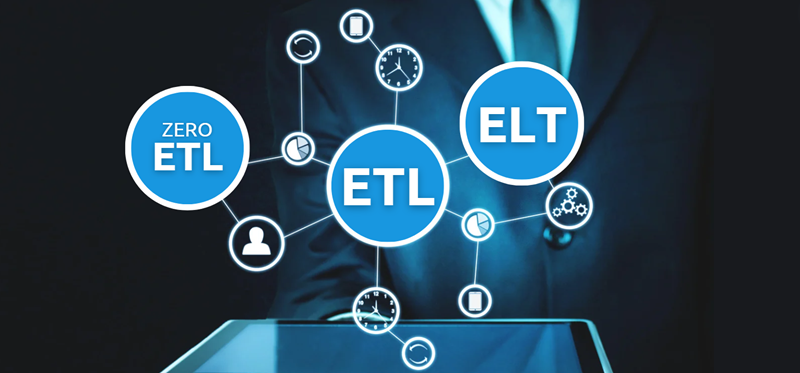
In today’s data-driven world, organizations of all sizes are constantly gathering and processing information. But simply collecting data isn’t enough; it’s the strategic integration and utilization of this data that unlocks its true value. In this article, we’ll explore three fundamental methods for data integration: ETL, ELT, and Zero-ETL. Each of these approaches comes with its own set of features, advantages, and challenges. Keep reading to discover which solution aligns best with your business needs.
ETL, ELT, and Zero-ETL: What Makes Each Approach Unique?
ETL (Extract, Transform, Load) is a traditional method for data integration. The process unfolds in three essential steps:
- Extract: Data is collected from various sources, including databases, spreadsheets, and external applications.
- Transform: The raw data is then transformed to meet the specific requirements of the destination system. This stage may involve filtering, cleansing, aggregating, and other operations that prepare the data for optimal use.
- Load: Finally, the transformed data is loaded into the destination system, such as a data warehouse, where it becomes ready for analysis and reporting.
ELT (Extract, Load, Transform) is an approach that reorders the final two stages—loading occurs before transformation. This shift allows for faster data ingestion, making it particularly effective when dealing with large datasets.
This change in the sequence is more than just a technical nuance; it significantly affects how the destination system operates and how data is stored. In the ETL process, only the processed and refined data is loaded into the destination database. In contrast, ELT involves loading raw data first, which can then be transformed as needed within the destination system.
This distinction gives ELT greater flexibility, as the raw data can be repurposed for various analyses and applications. However, ETL has its own advantages, particularly in terms of data quality. Since the data is processed before it’s loaded, ETL ensures that only clean, structured information enters the new database.
So, which method is right for your business? Keep reading as we explore the third approach, Zero-ETL, to help you make an informed decision.
Zero-ETL: The Next-Generation Approach to Data Integration
Zero-ETL represents a cutting-edge approach to data integration, where data is directly integrated between systems, enabling real-time processing. In this method, the traditional transformation stage is either automated or bypassed entirely, allowing raw data to be loaded directly. Platforms like FME are instrumental in implementing this approach.
Zero-ETL enables seamless data integration across different applications without the need for intermediary data warehouses. For instance, data from a CRM system can be automatically synchronized with an ERP system, even supporting two-way synchronization.
Commonalities Between ETL, ELT, and Zero-ETL
Despite their distinct approaches, ETL, ELT, and Zero-ETL share a common objective: the effective integration of data from multiple sources. By breaking down data silos, these methods enhance data accessibility and streamline operations, ultimately giving businesses a competitive edge.
Key Differences Between ETL, ELT, and Zero-ETL
While ETL, ELT, and Zero-ETL share the ultimate goal of effective data integration, their differences significantly influence the efficiency, scalability, and versatility of your data processes.
Efficiency and Scalability
- ETL can be time-intensive, particularly when dealing with large datasets. Since data transformation occurs before loading into the target system, this method demands substantial computing power to handle the processing efficiently.
- ELT is generally more efficient for handling large volumes of data, as the data is loaded first, and transformations are performed afterward within the target environment.
- Zero-ETL stands out as the most efficient approach, processing data in real-time through automated transformations or by directly transferring raw data.
Efficiency directly impacts scalability. Zero-ETL is the most adaptable to growing and evolving business needs due to its real-time processing and automation. In contrast, ETL is the most challenging to scale, as its pre-processing step can become a bottleneck as data volumes increase.
Capabilities
- ETL is a highly versatile tool, but it requires careful planning and design of the transformation process. As the complexity of your data grows, so does the complexity of the ETL process, which can become increasingly intricate and resource-intensive.
- ELT handles raw data, making it compatible with modern data processing techniques, such as AI and machine learning. However, the efficiency of ELT heavily relies on the performance of the target platform. The platform must be robust enough to manage large datasets and perform operations like executing SQL commands efficiently.
- Zero-ETL offers the advantage of rapid data integration across various sources without the need for manual process management. Additionally, it provides the flexibility to synchronize data not only within a data warehouse but also directly between different applications, enabling seamless data flow across your organization.
Pros and Cons of ETL, ELT, and Zero-ETL
ETL – Pros and Cons
The defining characteristic of ETL—data transformation before loading—presents both strengths and challenges. On the positive side, this pre-loading transformation ensures high data quality, as the data is thoroughly processed and refined before being integrated into the destination system. This approach allows for the use of external data processing services, enabling more complex operations and ensuring that only clean, structured data enters the system.
However, the advantage comes with drawbacks. The extensive processing time can be a limitation when dealing with large datasets. This delay can be problematic for dynamic organizations that rely on timely access to up-to-date information.
Additionally, designing advanced transformations necessitates the expertise of qualified specialists who can understand your business needs and tailor the data operations accordingly.
ELT – Pros and Cons
ELT offers faster data loading, which enhances both the efficiency of the process and the flexibility of the data. Since transformation occurs after data is loaded, the raw data can be processed in various ways depending on your specific needs.
ELT allows you to increase data quality in a limited way, e.g., by performing data validation or deduplication. To achieve the desired data quality, you may need to implement additional solutions within the destination system, which can complicate the data management process.
Moreover, storing large volumes of raw data can significantly increase storage costs, a critical factor for organizations dealing with extensive datasets. ELT necessitates robust mechanisms in the destination system to effectively manage and process raw data. Without these mechanisms, you may encounter issues related to data overload, leading to increased storage requirements and higher infrastructure costs.
The choice of the destination system is also crucial, as the efficiency of ELT depends heavily on the platform’s ability to handle raw data and perform necessary transformations.
Zero-ETL – Pros and Cons
Zero-ETL excels in speed and efficiency, leveraging modern automation to process data in real-time and reducing the risk of human error. Zero-ETL also doesn’t require traditional programming skills; it often relies on low-code and no-code platforms, making integration implementation and management more accessible and cost-effective.
Zero-ETL’s capabilities for data transformation are more restricted, making it less suitable for scenarios where extensive data processing is required during integration. Additionally, mechanisms for enhancing data quality, such as validation and standardization, may not be as robust with Zero-ETL.
Zero-ETL can minimize the costs associated with maintaining extensive infrastructure for data processing and storage. However, it’s important to note that tools enabling real-time synchronization can be more expensive than traditional data integration tools. As a result, the cost-effectiveness of Zero-ETL largely depends on your company’s specific needs and existing infrastructure.
Which Solution Should You Choose: ETL, ELT, or Zero-ETL?
ETL Use Cases
ETL is an ideal choice when your data requires complex transformations and processing before being loaded into the target system. While ETL is often associated with advanced operations, it can also be effectively used for less demanding tasks, such as synchronizing an application with a data warehouse.
For example, the ETL method was utilized to create a 3D model of the city of Poznań. In this project, data from Oracle and PostgreSQL databases were integrated.
ELT Use Cases
ELT is particularly well-suited for scenarios where large volumes of data need to be processed quickly and efficiently. It is commonly used when dealing with Big Data and cloud-based data warehouses, where the emphasis is on rapid data loading and flexible processing. For instance, ELT is ideal for handling logs related to user activity within applications or websites. These logs can be loaded quickly, and data analysts can then use SQL queries or other tools to process and analyze the data.

Zero-ETL Use Cases
Zero-ETL is the optimal solution for organizations that require immediate access to data and seek to automate their integration processes. It is particularly useful in situations where constant synchronization between various data sources is essential.
One of the significant advantages of the Zero-ETL approach is that it eliminates the need for a data warehouse. Data can be transferred directly between systems, such as CRM and ERP platforms, enhancing data availability. This allows organizations to monitor data in real-time, enabling quick responses to any outages or disruptions.

Leverage FME to Build Your Own Data Integration System with ETL, ELT, and Zero-ETL
When designing your data integration strategy, there’s no need to limit yourself to a single approach. Every organization can benefit from a combination of ETL, ELT, and Zero-ETL, creating a cohesive integration system tailored to its unique needs.
The FME Platform supports all these methods, making it an ideal foundation for data integration in any company. Here are its most powerful features:
Data Extraction
With FME, you can extract data from over 450 different sources. The platform’s support for APIs, Python, and R allows you to create custom integrations.
Transformation
FME’s visual editor empowers you to design both basic and advanced data operations, including data modification and validation. The intuitive drag-and-drop interface lets you manage data flows visually.
Process Automation
FME allows you to send data to data warehouses or directly transfer it between applications. With built-in process automation, you can achieve real-time synchronization by implementing the Zero-ETL approach.
For those working with raw data, the FME Platform offers robust tools designed specifically for this purpose. It also supports spatial data, enabling you to harness the power of Location Intelligence. A great example is the success story of our client, Visimind.
Ready to bring modern data integration solutions to your company? Contact us today to design a strategy that meets your specific needs and fully unleashes the potential of your data.











